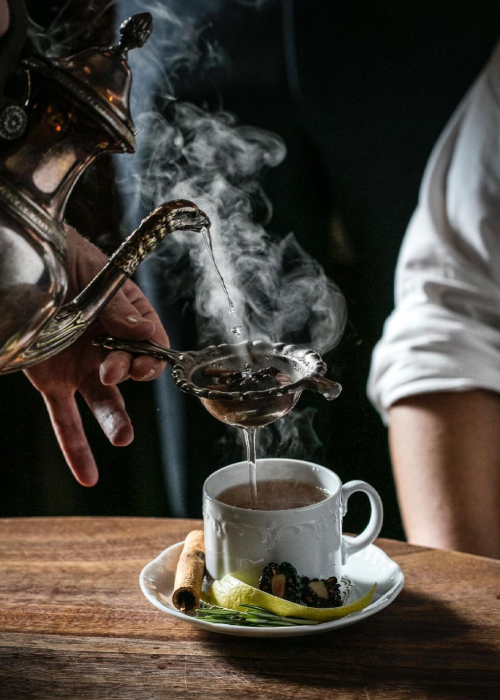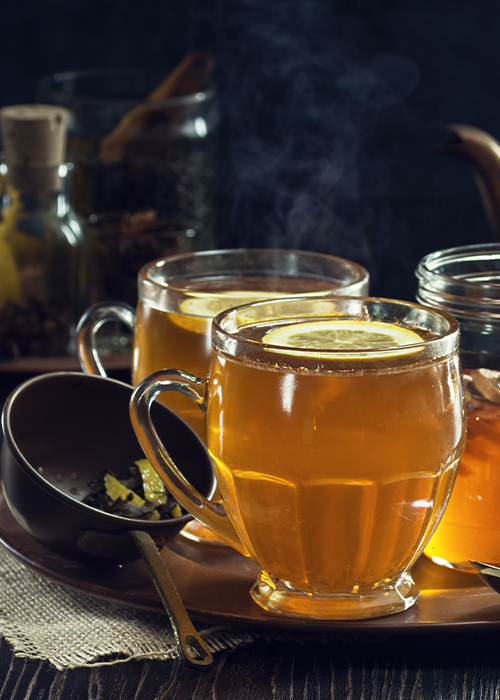When temperatures drop, few cocktails rise to the occasion quite so comfortingly as the Hot Toddy. A double whammy of booze and warmth, it serves the perfect antidote to winter chills and common colds, even if the latter may be solely by means of placebo.
Though simple to throw together, the drink shines brightest when treated as a bonafide cocktail — one that just happens to be served hot. For while a Toddy’s temperature is crucial, so too are the drink’s other constituents, and the manner in which they come together in glass or mug.
Most commonly used are lemon, honey, and whiskey. But the Hot Toddy offers so much more than that. Not just one drink but a template of components that can be tweaked with drastic effects, consider it the ultimate chameleon of the cocktail world.
Don’t miss a drop!
Get the latest in beer, wine, and cocktail culture sent straight to your inbox.
For guidance on how to navigate that path and to learn how to perfect this iconic winter cocktail, VinePair tapped a pair of leading bartenders and self-professed Hot Toddy aficionados.

What to Do When Making a Hot Toddy
1. Think of the Hot Toddy as a template.
Much like the so-called mother sauces that define classical French cuisine, the canon of cocktails can be broken down into different styles and then further into individual drinks that offer examples of each style. The Daiquiri, for example, is a type of “sour.”
When approaching the Hot Toddy, it’s crucial to think of the drink as the latter — an expansive style — says William Elliott, managing partner and bar director at New York’s Maison Premiere. “I think of the Hot Toddy as more of a preparation than it is a drink unto itself,” he says. “I see it as a template.”
Breaking this template down, we can separate the Hot Toddy into three separate components, which themselves may each comprise more than one ingredient: Base spirit(s), liquid used to provide heat and dilution, and ingredients that balance the final flavor profile.
2. Consider spirits beyond whiskey.
Putting his theory into practice, Elliott offers 11 different Hot Toddy variations at Maison Premiere. While each contains the same core ingredients and follows the same preparation, the base spirits provide the defining factor. Aged distillates, spanning Armagnac to American whiskey, form the bulk of the Toddy menu, while unexpected options can be sampled in the form of mezcal, cachaça, and Chartreuse.
“The knee jerk reaction for most people is to think of it as a whiskey cocktail,” he says. “But like a lot of cocktails, there’s not a lot of clarity on the origin story or an origin spirit.”
Mark Phelan, beverage director at Chicago hospitality collective 16” On Center, agrees that many base spirits can be used for the cocktail, with fruit-forward mezcals being a left-field personal favorite of his.
While both bartenders encourage experimentation, there are, of course, limits to the returns gained from stepping outside the box. (Vodka Hot Toddy, anyone?) Similarly, Phelan feels that, for most drinkers, the Hot Toddy remains a whiskey cocktail.
Phelan describes the base spirit as providing the “backbone of flavor” for the Hot Toddy, informing not just how the final drink will taste but also guiding which other ingredients he will include in the cocktail. “It’s the inspiration for me,” he says. “I’m thinking: How do I bring out the flavors of this base spirit and what ingredients will help lift it up?”
3. Dilute with flavor.
One of the ways to enact such elevation comes via the Hot Toddy’s second component: the liquid used to control temperature and provide dilution.
Where ice performs both functions in regular cocktails, the warm liquid added to the Hot Toddy carries the additional bonus of potentially contributing flavor. “Whether it’s tea or cider, or even just steeping some ingredients in hot water before you pour it,” Phelan says, “that’s where you can have a lot of fun. Dilution is a huge opportunity.”
Rooibos and herbal teas are go-to options for Phelan. He favors them for their aromatic qualities and a lack of caffeine, which is an important consideration if the drink serves as a nightcap. At Maison Premiere, meanwhile, Elliott pours steaming hot water over a tea strainer containing cardamom pods, cinnamon, allspice, and juniper berries for his flavorful dilution component.
4. Balance sweetness, acidity, and bitterness.
Perhaps the closest manner in which the Hot Toddy matches “regular” cocktails is the need to balance the core components of flavor: sweetness, acidity, and bitterness. In some instances, doing so offers another opportunity to bring additional elements to the drink.
Elliott swears by a “very potent” ginger syrup in his version of the drink, though he includes it sparingly. He also opts for just half an ounce of fresh lemon juice, then provides the final touch with aromatic bitters. “It seems like a no-brainer to me,” he says. “When you dash bitters into something that’s warm, it’s even more evocative than in a cold cocktail because you have all these aromatics that are just coming alive with the warmth.”
When introducing sweet and sour components, Phelan warns that the higher temperature of this cocktail impacts the quantity needed versus colder drinks. “When a drink is hot, the perception of sugar is lower,” he explains. “So you have to use a little more than you would think is normal.” By contrast, the citrus element is almost heightened by the heat, so using less is better, he says.
Phelan agrees that it’s useful to have a selection of bitters on hand, and recommends allspice and chocolate mole bitters as versatile options. “Those are great ways to inflect flavor when you don’t have a really nice tea or a fancy syrup,” he says.

What Not to Do When Making a Hot Toddy
5. Don’t forget that this is a ‘hot’ cocktail.
Of course, the defining aspect of the Hot Toddy is its temperature, so it goes without saying that both professionals pay close attention to this aspect of preparation.
For Maison Premiere’s version, the bar team will build all the ingredients minus the hot water and tea strainer in a regular shaker tin. They then fill a larger tin with scalding hot tap water and sink the shorter tin into it, bringing the mix of ingredients up to a reasonable room temperature.
Elliot warns against opting for a more aggressive form of heating, such as a stovetop. “You’re just going to burn off alcohol,” he says, “and you’re going to mutate this citrus profile.”
Both recommend warming the serving vessel prior to introducing any ingredients. Phelan also heats the tea he will use for dilution to a higher temperature than might be perfect at first sip. “The drink might end up a touch hotter than it needs to be,” he says. “So you can sit there and hold it in your hands for a second.”
6. Don’t go too big.
One final factor to focus on is correct glassware, which impacts both temperature and balance of the final drink. Serve a Hot Toddy in a vessel that’s too large and the chances of over-diluting run high. Plus, “if the drink’s too big, it’s impossible to get through before it turns into a room-temperature cocktail,” Phelan says. “The sweet spot for me is 6 to 8 ounces — that’s the size of the glass I’m looking for.”


